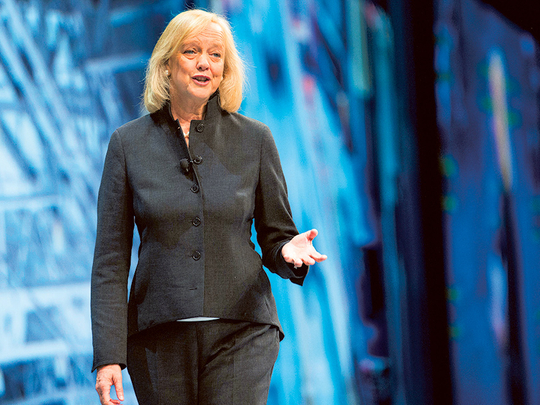
New York: For months, technology companies have pursued Amy Chang.
The calls are relentless, with several feelers a month, said Chang, the chief executive of Accompany, a Silicon Valley start-up. Even when she declines the overtures, the tech companies and their agents keep coming back, asking the same question: Will you please join our board?
“I turned down 15 to 20 first meetings” about joining a company board this year, said Chang, 39, who was an executive at Google for seven years before founding Accompany, which makes an executive-briefing app. “This whole thing is so crazy.”
Chang eventually agreed to one invitation. In October, she was appointed to the board of Cisco Systems, the behemoth Silicon Valley maker of networking gear. The role pays her a $75,000 annual retainer and gives her a grant of restricted stock worth several hundred thousand dollars. She is now the youngest of Cisco’s 11 board members by at least a decade, and one of four women.
Even by Silicon Valley standards, where recruiting wars are legion, attracting women to join tech company boards has become intense. While many companies still want the highest-profile women in the industry — think Sheryl Sandberg of Facebook or Meg Whitman of Hewlett Packard Enterprise — a new pool of candidates is also being hotly pursued.
And those women are younger, tend to be ethnically diverse and have grown up in digital businesses for much of their careers.
The competition for these women is thriving as tech companies are under growing pressure to diversify their boards. While Twitter and other tech companies have taken steps to add more women to boards, the tech industry still lags others in gender diversity. Among Silicon Valley’s 150 largest companies, only 15 per cent of board seats were filled by women in 2016, compared to 21 per cent for companies in the Standard & Poor’s 500 Index, according to the research firm Equilar.
A lack of diversity permeates many parts of the tech industry — the overall workforces of companies like Facebook, Google and others strongly skew male — but boardrooms are a particular focus because they are power centers that can help spur broader changes. Board positions are often coveted for their prestige and big paychecks; median pay for directors at large public companies was $270,000 in 2015, according to Equilar.
Chang is one of the new generation of tech women who are now being courted to close that gap. Others include Stacy Brown-Philpot, the chief executive of TaskRabbit, a San Francisco start-up that connects people to cleaners, handymen and others who do household tasks. Brown-Philpot was appointed to her first public company board, HP Inc., in 2015.
Also in demand are Selina Tobaccowala, who runs the start-up Gixo, and Clara Shih, the chief executive of Hearsay Systems, who joined the board of Starbucks five years ago, at age 29, executive recruiters said.
“Boards are looking at diversity across multiple dimensions, such as gender, ethnicity, age and unique skill sets,” said David Chun, the chief executive of Equilar, which tracks board candidates and executive compensation. “If you can bring a number of these different attributes and perspectives to the boardroom, you’ll be in high demand.”
The clamour for these women has spread beyond Silicon Valley’s large public tech companies to privately held start-ups as well, some of which could emerge as the next public giants. Glenn Kelman, the chief executive of Redfin, a closely held online real estate brokerage, said he sometimes had to mount “pitched efforts” to attract female candidates to his company’s nine-member board, because many other start-up chief executives were after the same people.
“A lot of executives are trying to do this,” Kelman said. “If I dilly-dallied, suddenly everyone was recruiting” the same person.
In November, Redfin brought on two new directors, including Julie Bornstein, the chief operating officer of Stitch Fix, an online personal stylist service. Bornstein is the second woman serving on Redfin’s board. In 2014, the company added Tobaccowala, a co-founder of Evite who was later a top executive at the online polling company SurveyMonkey.
Bornstein, 46, a former chief digital officer at Sephora, said she had gotten 30 or 40 calls to discuss joining a corporate board over the last few years, even though she had never sat on one. Before becoming a member of Redfin’s board, Bornstein said, she also talked to two public companies about a board spot, though she lost out to other women for those positions.
Yet many hurdles still prevent women from joining more tech boards, Bornstein said. As she interviewed at companies about board seats, she said, she found that many directors typically stuck to their own networks of acquaintances for candidates. That generally led to looking at the same people over and over again.
As a rule of thumb, boards also want experienced members. Part of the reason Bornstein said she did not land other board positions was because “they couldn’t get their head around someone who hadn’t been on a board before.”
Because there are “fewer natural high-profile women in tech,” she said, “it requires taking bets on new people.”
Efforts are afoot to break down those risks and bring new candidates to attention. Sukhinder Singh Cassidy, the founder and chairman of Joyus, a video and e-commerce start-up in San Francisco, started an initiative called the Boardlist in mid-2015 to highlight women qualified to be on boards.
To be on the list, a candidate must be endorsed by a Boardlist member, many of whom are venture capitalists, tech executives and others.
The Boardlist now has 1,300 names, up from 600 when the effort began, Singh Cassidy said. Less than half of those on the list have prior board experience, reflecting the up-and-coming nature of the group. Companies seeking a female board member can search through the list for ideas.
“There’s a lot of educating that needs to be done,” said Singh Cassidy, who is on the boards of TripAdvisor and Ericsson. But she said she was encouraged that some of the larger tech companies had embraced board diversity, which has spilled over to start-ups.
“There has been pressure from all parts of the ecosystem, which has created a groundswell,” she said.
In the end, it often takes a chief executive to be open-minded about recruiting a different type of board member. That is what happened with Chang at Cisco.
Chang led Google Analytics, a popular service that tracks website traffic, and is on the board of a small public software company, Splunk, but she still maintains a low profile in Silicon Valley. In August, her start-up, Accompany, released its app, which blends profiles of contacts with calendaring, email extensions and other tasks.
That kind of résumé is atypical of board members at Cisco, where directors tend to be more experienced. The company’s longtime board members include John L. Hennessy, 64, the former president of Stanford University, and Carol Bartz, 68, the former chief executive of Yahoo.
Yet Chang’s differences were precisely what drew Chuck Robbins, Cisco’s chief executive. After seeing the Accompany app and learning about Chang, he met with her and they hit it off. Chang soon interviewed with other Cisco board members, who concluded she would be an asset, Robbins said.
“It’s all about bringing on fresh perspectives and a different set of experiences,” he said. “That means they bring a different set of thinking to the boardroom.”
New York Times News Service












